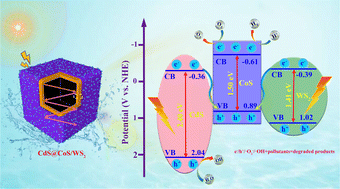Hollow cubic CdS@CoS/WS2 dual S-scheme heterojunction superstructure toward optimized photothermal–photocatalytic performance†
Abstract
A hollow polyhedral structure can effectively capture light and facilitate carrier separation, thus enhancing photocatalytic performance. Herein, hollow cubic CdS@CoS/WS2 dual S-scheme heterojunction superstructure photocatalysts are fabricated using a simple sulfidation and hydrothermal method. CdS@CoS/WS2 with a band gap of 1.59 eV and a relatively narrow band gap broadens the photoreaction to the near-infrared region and shows a good photothermal effect, which can promote photocatalytic reactions. It shows a relative specific surface area of 91.58 m2 g−1, which provides abundant surface-active sites to enhance the photocatalytic reaction. Under light conditions, the photocatalytic degradation ratios of CdS@CoS/WS2 for tetracycline and bisphenol A are up to 98.9 and 99.1%, and the hydrogen evolution efficiency is also up to 10.62 mmol h−1 g−1. The enhanced photothermal–photocatalytic performance could be due to the formation of a dual S-scheme heterojunction superstructure that facilitates space charge separation, a narrow band gap and a mesoporous hollow structure promoting solar light utilization, providing abundant surface-active sites and enhanced mass transfer. This simple strategy provides a new idea for the construction of high-performance hollow superstructure photocatalysts.

- This article is part of the themed collection: Journal of Materials Chemistry C HOT Papers


 Please wait while we load your content...
Please wait while we load your content...